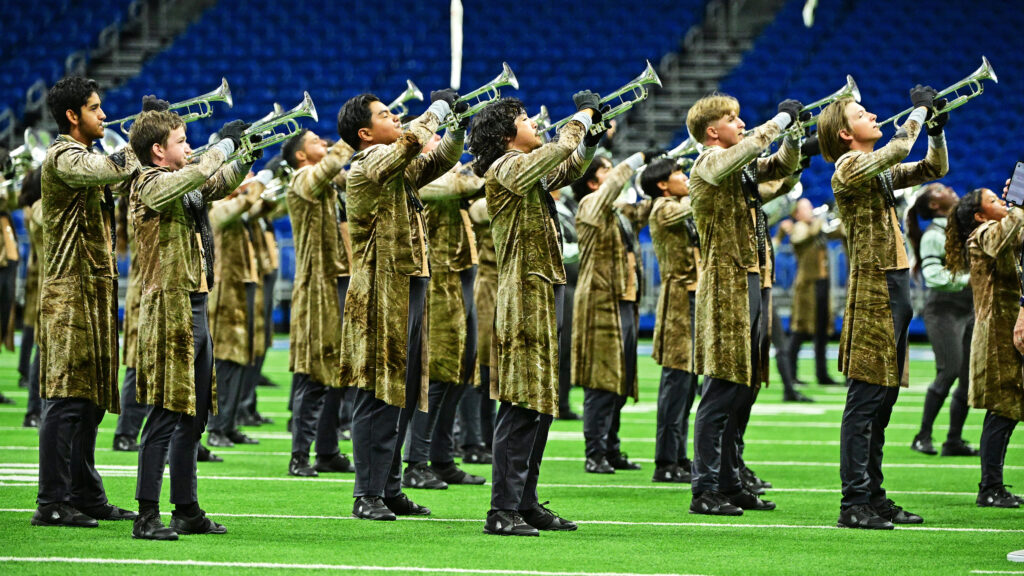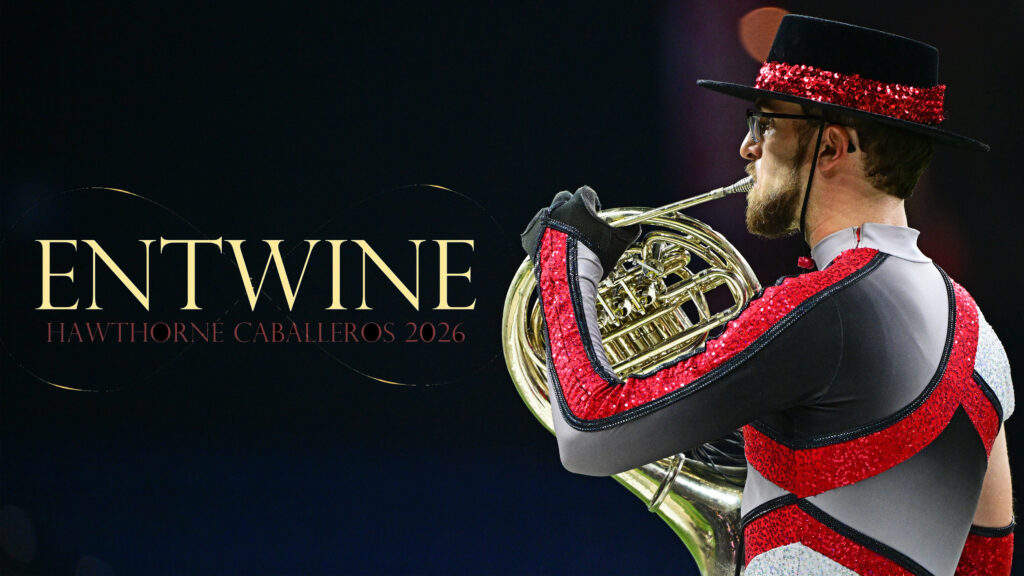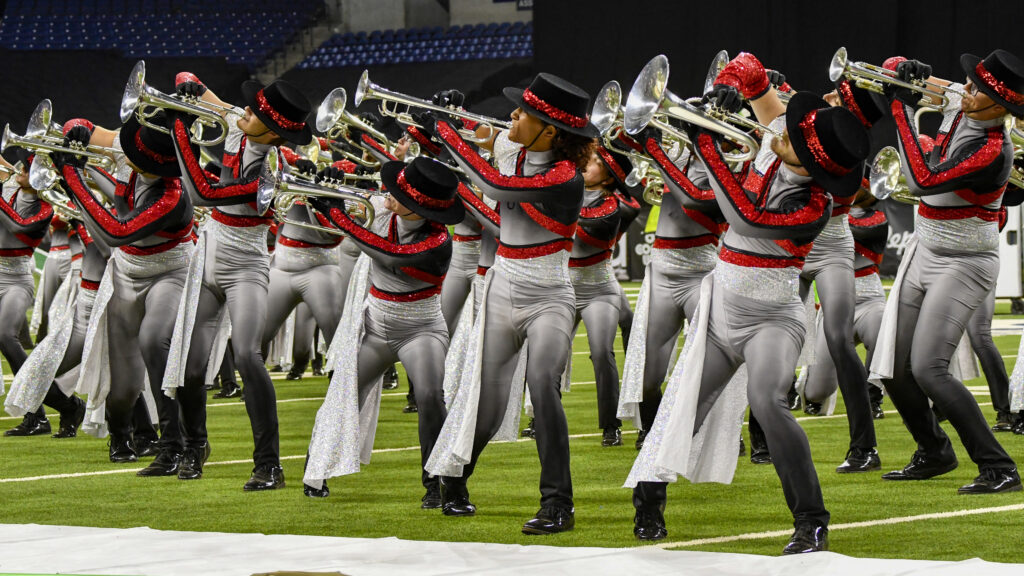In a season that appeared to be anyone’s for the taking coming into the last week of the summer, the Blue Devils amazingly went on to win the 2015 Drum Corps International World Championship Finals despite placing fourth in the Prelims competition due to a warm-up penalty.
A season chock full of entertaining productions, perhaps two of 2015’s most intriguing visual effects were The Cadets turning every yard line into 10-yard lines for the corps’ “The Power of Ten” show, and Santa Clara Vanguard wheeling out large Tesla coils for “The Spark of Invention.” Boston Crusaders celebrated the corps’ 75th anniversary with “Conquest,” named for the Alfred Newman piece that is a corps icon.
Finishing 2015 in 11th place, the Blue Stars performed “Sideshow,” a production about life under the big top of a traveling circus.

The opening portion of the show commenced with an eerie front ensemble rendition of “The Daring Young Man on the Flying Trapeze,” an 1867 song written by Gaston Lyle and Alfred Lee to honor the high-flying prowess of the famed Jules Léotard, whose last name became popularly attached to the one-piece garment often worn by dancers. The piece became a classic in the world of vaudeville and in a number of movies.
The corps’ color guard members, initially dressed as locals, poured out onto the field, eager to attend the distraction of the circus. As the show progressed, they would evolve through various costume changes to become the circus performers themselves.
The setup continued with hints of Jeff Beal’s “Carnivále,” written for a two-season HBO television series that first aired in 2003 and was set during the devastating Great Plains Dust Bowl of the 1930s Great Depression. This was also the time period and locale in which “Sideshow” was set.
After the announcer’s introduction of the production, the Blue Stars marched into the formation of a big top tent as the brass section performed a hint of “Entrance of the Gladiators,” composed in 1897 by Czech composer Julius Fučík. The work is sometimes known as “Thunder and Blazes,” and has long been associated with circuses, often used as a march to introduce a bevy of clowns.
Three sideshow stages were scattered across the field, serving as performance areas for special acts and places for the color guard to store equipment underneath. Kicking off the featured acts was Ariel, the “treasure of the trapeze” (whose stage name was cleverly a homonym for “aerial”), popped out from behind the curtains of one of the stages to walk on the shoulders of horn players.
“The Human Rubber Band” was next to appear, introduced by the circus ringmaster as being “bendable, flexible,” and “unbreakable.” He demonstrated feats of elasticity that may have been painful for some of the more inflexible audience members to watch, accompanied by the musical flexibility of trombone glissandos.

“Madame Clara sees all” was announced as a seer came out to read the palm of a flugelhorn soloist. Following her was an accomplished juggler who joined the corps as a trumpet player, not expecting to become one of the main acts. The staff initially didn’t know of his special talent; and even after the show theme was decided, he didn’t tell anyone. It was up to the corps’ brass arranger, Richard Saucedo, to mention that the trumpeter—who happened to be drum major at the school where Saucedo taught—was also a world-class competitive juggler.
A set of conjoined twins followed a sword swallower, performing to “I Will Never Leave You.” Henry Krieger and Bill Russell wrote the piece for the 1997 Broadway play, “Sideshow,” which is based on the real lives of a set of conjoined twins who were famous 1930s vaudeville performers. Appearing to be attached at the hip, they passed one flag between themselves as a trumpet duet belted out the melody, joined in spinning by multiple other guard members performing as conjoined twins.
That musical production seamlessly segued into Stephen Sondheim’s “Send in the Clowns,” written for the 1973 musical, “A Little Night Music.” Now a standard repertoire selection by jazz singers, it is perhaps best known for the Judy Collins version that hit the charts in the mid 1970s.
The segue of one work into another in the Blue Stars’ production, reflected the concept of the three-ring circus which had multiple acts going on simultaneously and was meant to offer viewers a sensory overload of concurrent images. By this point the color guard performers were dressed as clowns in various designs, all based on shades of light blue.
“Liz the Limber Girl” picked up a sledgehammer and tried her luck at the “Hi-striker,” the feat of strength that was like a giant thermometer measuring degrees of strength.
A snippet of “Entrance of the Gladiators” returned in the front ensemble percussion section as the horns rotated a large Ferris wheel around one of the sideshow stages, leading into a giant star form and the grand finale that had several of the prior acts return for a final bow.
2015 Overview

Michael Boo was a member of the Cavaliers from 1975-1977. He has written about the drum corps activity for more than 35 years and serves as a staff writer for various Drum Corps International projects. Boo has written for numerous other publications and has published an honors-winning book on the history of figure skating. As an accomplished composer, Boo holds a bachelor's degree in music education and a master's degree in music theory and composition. He resides in Chesterton, Indiana.





